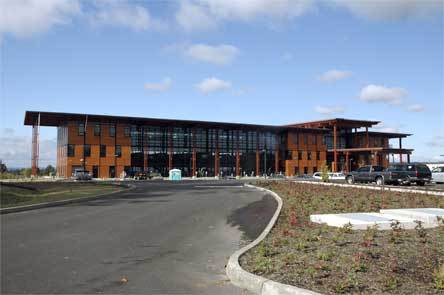TULALIP — The Tulalip Tribes invited members of the Marysville and Tulalip communities to the Oct. 3 grand opening of the Tribes’ new administration building, which officially opened for business Sept. 14.
Tulalip Tribes Chair Mel Sheldon Jr. welcomed a host of area dignitaries, including Bureau of Indian Affairs Puget Sound Superintendent Judy Joseph, Snohomish County Boys and Girls Clubs Executive Director Bill Tsoukalas, Marysville School District Assistant Superintendent Gail Miller and Director District 1 candidate Chris Nation, Steve Muller of the Marysville YMCA and Marysville Rotary, Greater Marysville Tulalip Chamber of Commerce President and CEO Caldie Rogers, and state Rep. John McCoy, who also serves as general manager of Quil Ceda Village.
Sheldon deemed the 75,000-square-foot administration building a huge expression of how members of the Tulalip Tribes have come together to invest in their community and carry on the work of their elders. He also acknowledged the vision and sacrifice of past and present Tribal Boards of Directors for making this building possible, and raised his hands in appreciation to the Tribal members who have served in the military, before pointing out that the building grounds will include a veterans memorial.
Sheldon described the dream of making Tribal government more efficient and effective by bringing together all of its services under one roof. The three-story administration building replaces 65 older buildings which had been scattered throughout the Tulalip Reservation, and provides offices for 24 departments, 200 employees, and the Tribal executive directors, general manager and Board of Directors.
Tribal Board Vice Chair Marie Zackuse, Treasurer Chuck James, Secretary Marlin Fryberg Jr., and members Stan Jones Sr., Glen Gobin and Tony Hatch all offered their thoughts on the new building. Gobin admitted that “it was difficult to move away from Tulalip Bay,” which was why he appreciated the new building’s view of the bay, as well as its room to expand. Jones recalled how the Tribal offices have grown from three employees to more than 3,000 during his time. Zackuse echoed Sheldon by thanking he Tribes’ early leaders for “paving the way and laying the foundation for where we are today, and making due with the little resources they had.”
“The view from my office used to be of a toilet bowl in the gymnasium,” Fryberg laughed, before he cited the role that Tribal development played in making the building possible. While Fryberg sees the building as an inspiration to “take pride in what we have,” Hatch called it “one of the best things the Tribes have done,” by cutting down on the drive time required to obtain different services. James echoed Hatch’s opinion, since “it’s difficult to be a walk-around manager for 65 different locations.” James spoke of the need to find new venues, and noted that the Lushootseed name of the administration building translates to “the place where we make available training, teaching and advice both spiritual and practical.”
The first floor of the administration building includes a main reception area, with specific counters set aside for each area of customer service, and the finance cashier’s desk, where Tribal members can make payments. It also houses the offices for natural resources, Temporary Assistance for Needy Families, the Tribal Employment Rights Office and Geographic Information Systems, as well as the building’s receiving area and largest training room.
The administration building’s second floor houses the enrollment, technology and teaching departments, the latter including Lushootseed, as well as the Tribal Housing Assistance Programs, a copy center and a workout room, with weights and spaces for aerobics. The latter room is complimented by locker rooms for men and women, which include showers, lockers and changing areas. All three floors include data servers, offices for executive directors, conference and training rooms, and kitchenettes, but only the second floor has a common eating area, since employees are not allowed to eat food in their cubicles. A soundproof room for making audio recordings is still under construction.
The third floor of the administration building houses the public Board meeting room, private discussion rooms and offices for the Board members and chair. It also includes a locked-down area for departments which handle sensitive and confidential materials, including finance, payroll, grants, self-governance, legal, human resources and communications.
The administration building as a whole was designed to utilize as much natural energy and light as possible, in part by being made from cedar products and featuring environmental technology such as thermal wells and skylights. A “phase two” adjacent early learning center and 2,000-seat Tribal gathering hall are planned for 2010.
“Once again, Indian country will look toward Tulalip and ask, ‘What have they done now?’” Sheldon said. “By building our admin center, we have invested in ourselves and accomplished one of the objectives of our gaming opportunity. We are doing it the Tulalip way.”
Click here for more photos.



